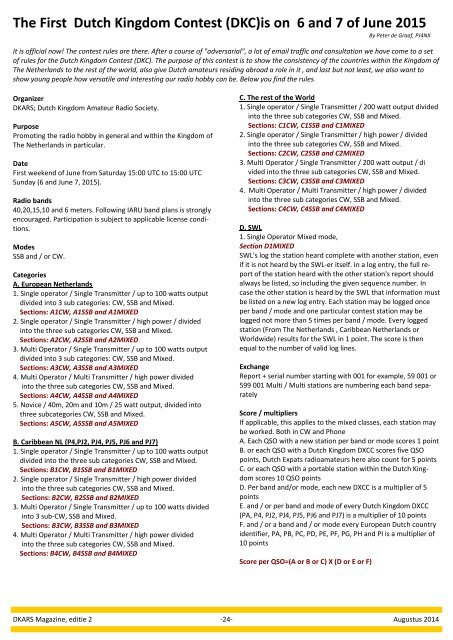magazine-201408
magazine-201408
magazine-201408
- No tags were found...
Create successful ePaper yourself
Turn your PDF publications into a flip-book with our unique Google optimized e-Paper software.
The First Dutch Kingdom Contest (DKC)is on 6 and 7 of June 2015<br />
By Peter de Graaf, PJ4NX<br />
It is official now! The contest rules are there. After a course of "adversarial", a lot of email traffic and consultation we have come to a set<br />
of rules for the Dutch Kingdom Contest (DKC). The purpose of this contest is to show the consistency of the countries within the Kingdom of<br />
The Netherlands to the rest of the world, also give Dutch amateurs residing abroad a role in it , and last but not least, we also want to<br />
show young people how versatile and interesting our radio hobby can be. Below you find the rules.<br />
Organizer<br />
DKARS; Dutch Kingdom Amateur Radio Society.<br />
Purpose<br />
Promoting the radio hobby in general and within the Kingdom of<br />
The Netherlands in particular.<br />
Date<br />
First weekend of June from Saturday 15:00 UTC to 15:00 UTC<br />
Sunday (6 and June 7, 2015).<br />
Radio bands<br />
40,20,15,10 and 6 meters. Following IARU band plans is strongly<br />
encouraged. Participation is subject to applicable license conditions.<br />
Modes<br />
SSB and / or CW.<br />
Categories<br />
A. European Netherlands<br />
1. Single operator / Single Transmitter / up to 100 watts output<br />
divided into 3 sub categories: CW, SSB and Mixed.<br />
Sections: A1CW, A1SSB and A1MIXED<br />
2. Single operator / Single Transmitter / high power / divided<br />
into the three sub categories CW, SSB and Mixed.<br />
Sections: A2CW, A2SSB and A2MIXED<br />
3. Multi Operator / Single Transmitter / up to 100 watts output<br />
divided into 3 sub categories: CW, SSB and Mixed.<br />
Sections: A3CW, A3SSB and A3MIXED<br />
4. Multi Operator / Multi Transmitter / high power divided<br />
into the three sub categories CW, SSB and Mixed.<br />
Sections: A4CW, A4SSB and A4MIXED<br />
5. Novice / 40m, 20m and 10m / 25 watt output, divided into<br />
three subcategories CW, SSB and Mixed.<br />
Sections: A5CW, A5SSB and A5MIXED<br />
B. Caribbean NL (P4,PJ2, PJ4, PJ5, PJ6 and PJ7)<br />
1. Single operator / Single Transmitter / up to 100 watts output<br />
divided into the three sub categories CW, SSB and Mixed.<br />
Sections: B1CW, B1SSB and B1MIXED<br />
2. Single operator / Single Transmitter / high power divided<br />
into the three sub categories CW, SSB and Mixed.<br />
Sections: B2CW, B2SSB and B2MIXED<br />
3. Multi Operator / Single Transmitter / up to 100 watts divided<br />
into 3 sub-CW, SSB and Mixed.<br />
Sections: B3CW, B3SSB and B3MIXED<br />
4. Multi Operator / Multi Transmitter / high power divided<br />
into the three sub categories CW, SSB and Mixed.<br />
Sections: B4CW, B4SSB and B4MIXED<br />
C. The rest of the World<br />
1. Single operator / Single Transmitter / 200 watt output divided<br />
into the three sub categories CW, SSB and Mixed.<br />
Sections: C1CW, C1SSB and C1MIXED<br />
2. Single operator / Single Transmitter / high power / divided<br />
into the three sub categories CW, SSB and Mixed.<br />
Sections: C2CW, C2SSB and C2MIXED<br />
3. Multi Operator / Single Transmitter / 200 watt output / di<br />
vided into the three sub categories CW, SSB and Mixed.<br />
Sections: C3CW, C3SSB and C3MIXED<br />
4. Multi Operator / Multi Transmitter / high power / divided<br />
into the three sub categories CW, SSB and Mixed.<br />
Sections: C4CW, C4SSB and C4MIXED<br />
D. SWL<br />
1. Single Operator Mixed mode,<br />
Section D1MIXED<br />
SWL's log the station heard complete with another station, even<br />
if it is not heard by the SWL-er itself. In a log entry, the full report<br />
of the station heard with the other station's report should<br />
always be listed, so including the given sequence number. In<br />
case the other station is heard by the SWL that information must<br />
be listed on a new log entry. Each station may be logged once<br />
per band / mode and one particular contest station may be<br />
logged not more than 5 times per band / mode. Every logged<br />
station (From The Netherlands , Caribbean Netherlands or<br />
Worldwide) results for the SWL in 1 point. The score is then<br />
equal to the number of valid log lines.<br />
Exchange<br />
Report + serial number starting with 001 for example, 59 001 or<br />
599 001 Multi / Multi stations are numbering each band separately<br />
Score / multipliers<br />
If applicable, this applies to the mixed classes, each station may<br />
be worked. Both in CW and Phone<br />
A. Each QSO with a new station per band or mode scores 1 point<br />
B. or each QSO with a Dutch Kingdom DXCC scores five QSO<br />
points, Dutch Expats radioamateurs here also count for 5 points<br />
C. or each QSO with a portable station within the Dutch Kingdom<br />
scores 10 QSO points<br />
D. Per band and/or mode, each new DXCC is a multiplier of 5<br />
points<br />
E. and / or per band and mode of every Dutch Kingdom DXCC<br />
(PA, P4, PJ2, PJ4, PJ5, PJ6 and PJ7) is a multiplier of 10 points<br />
F. and / or a band and / or mode every European Dutch country<br />
identifier, PA, PB, PC, PD, PE, PF, PG, PH and PI is a multiplier of<br />
10 points<br />
Score per QSO=(A or B or C) X (D or E or F)<br />
DKARS Magazine, editie 2 -24- Augustus 2014


